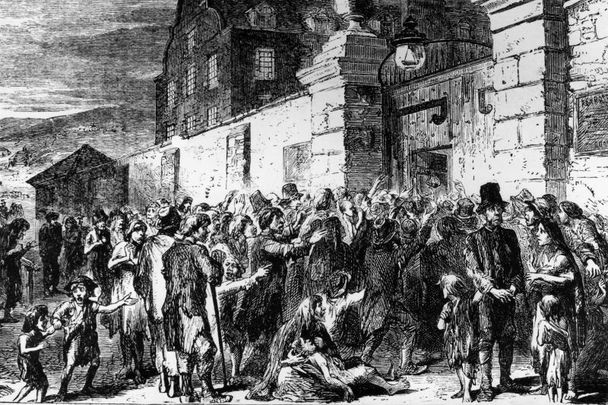Digitalized records reveal that even highly trained professionals were forced into workhouses by the misery of the Irish famine.
Over 2.5 million historical records revealing the hardship of Ireland’s poorest people are available online. The family history website Findmypast has released the Dublin Workhouse Admission & Discharge Registers and Minute Books.
The records provide a unique view of the impact the famine had on all aspects of the Irish population, as hundreds of thousands of middle-class Dubliners – alongside the impoverished working classes – were institutionalized in the workhouses between 1840 and 1919.
During the famine, millions of people had reason to use the workhouses and other services supplied by the Poor Law Unions. Until 2015, these records were never before indexed let alone made available online, and, given the lack of 19th-century census material in Ireland these records are an incredibly valuable census substitute.
Those professionals institutionalized in the Dublin workhouses include:
- 1,130 doctors and nurses
- 1,056 teachers
- 321 soldiers
- 321 soldiers
- 175 solicitors and lawyers
- 125 artists
- 32 clergymen
- 24 policemen
Individual notable figures in the records include:
- A 35-year-old author, George Fitzgibbon Lysaght entered the North Dublin Union Workhouse in 1853. Before falling on hard times, George was a wealthy landowner in County Clare. The property was auctioned off on May 6, 1858. The house division on his estate alone was 133 acres with a yearly rent valued at £110 and ten shillings.
- Soldier, Edward Byrne, entered the South Union Workhouse in 1850, aged 26. He was described as being in good health despite having a “ragged look.”
- Gerald Keogh, a 75-year-old widowed physician entered the North Dublin Union workhouse in 1848. He was described as being of “delicate” health. He died the following year.
- In 1853 solicitor Stephen Cullen and his wife, Julia Anna Maria Cullen, entered the North Dublin Union. Stephen was a 73-year-old from Scotland who was suffering from a “chest affliction” when he entered the workhouse.

Love Irish history? Share your favorite stories with other history buffs in the IrishCentral History Facebook group.
Those from poorer backgrounds include:
- Prostitutes, including Julia Goodwin, 40 years old, entered the Rathdown Union workhouse in 1843. She was listed as Rheumatic and the cause of her admission was listed as ‘misconduct’
- 81-year-old Mary Cohen, one of the oldest to be recorded. She entered the North Dublin Union in July 1846, “ragged and dirty.” She was dead by November.
- Eliza Abbey, a 3-month-old baby found by a policeman on March 31, 1867 on Abbey Street and handed over to a nurse 2 days later
- Jane and Thomas Tierny, siblings aged 7 and 6 were delivered at the workhouse in 1867. They had been deserted by their parents who had gone to America, which was not a particularly unusual situation
The collection of almost 900,000 records, made up from Board of Guardians Minute Books, cover meetings held by the Board of Guardians of four Dublin workhouses from 1839 to 1922. They contain the minutes of meetings, including supplies, hiring of staff, case histories of individual paupers and letters received by the Board, among other details, providing rich contextual detail of daily life in the workhouse.
Over 1,500,000 records detailing arrivals at the workhouse with details of each occupant's age, occupation, religion, any illnesses or infirmities, other family members, original parish and condition when they arrived including clothes and cleanliness.
Brian Donovan, Irish Records Expert at Findmypast said, “Workhouse records are an essential tool for family history research. They provide extraordinary detail and incredible heart-wrenching stories about some of the most poorly documented people who lived in Ireland.”
Levels of poverty in Ireland were far higher than in England so the workhouse was often an inescapable part of life. As many, if not most, Dublin families would have had some experience of the workhouses, this record set is one of the most significant available for those researching Dublin history.
The Dublin workhouse records are the first Irish workhouse records to go online as part of this project. Findmypast is working with the National Archives of Ireland to bring workhouse records online from every county in Ireland.
*Originally published in May 2015, updated in April 2023.




Comments